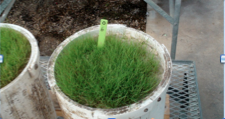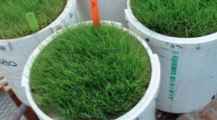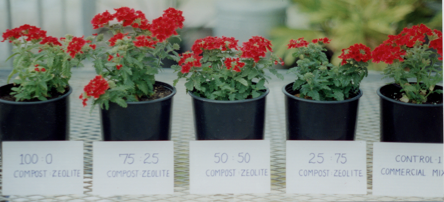Complete Plant Growth Medium (US Patent No. 8,034,147 B2)
A Complete Plant Growth Medium (CPGM) (US Patent No. 8,034,147 B2) can be used alone or in combination with native soils, manufactured soils, or compost. The inventors are Dr. Rajan K. Vempati and former Dr. Ramesh S. Hegde of ChK Group, Inc., Plano, TX and Dr. John J. Sloan of Texas AgriLife Research, Dallas, TX. CPGM is made by coating nanophase Fe oxide on to a zeolite (U.S. Patent No. 6,921,732). The design of this medium is based upon sound scientific and environmentally friendly principles. There are several unique characteristics of CPGM that supports plant growth, acts as a soil conditioner, and supplies plant nutrients. Research and test demonstration plots show that except for periodically watering the plants, one can forgo fertilizer application up to 30 days or more depending on the type of plant species, conserving and saving fertilizer and water usage.
The National Aeronautics Space Administration (NASA) acknowledged in a scientific project review, that the CPGM technology can be adapted for growing plants either in space or extraterrestrial bases and highly commended the technical merits and potential commercial values of the product.
Benefits of CPGM for home or professional gardeners:
- Retains both cationic (positively charged, e.g. NH4+) and anionic (negatively charged, e.g. H2PO4–) forms of the 16 essential plant nutrients.
- Increases plant yield.
- Exhibits excellent filtration and water holding capacity, resulting in cost savings on scarce and precious water.
- Serves as a good soil conditioner.
- Prevents leaching and/or runoff nutrients, e.g., nitrogen, phosphorus and other nutrients thereby minimizing water pollution.
- Increases fertilizer use efficiency by minimizing pollution, thereby, significantly decreasing the number of fertilizer applications in the field or pots.
- Captures nutrients from wastewater and liquid animal waste.
- Supplements the growing medium for indoor plants, vegetables and flower-beds which are primarily composed of manufactured or native soils.
- Serves as a potting medium or as a blend with municipal compost.
- In urban landscaping decreases the leaching of nitrogen, phosphorus and other nutrients into sewer or storm drains.
- Makes possible the use of poor quality water for plants.
- Non-biodegradable in CPGM does not deteriorate with time; therefore, it’s long-lasting and offers long-term benefits.

(a)

(b)
Fig. 1. Growth of a golf grass after six weeks of seeding: (a) control sand pot, and (b) sand containing 5% CPGM and 95% sand mix (middle pot with orange label), the left is control pot, and on 10% CPGM and 90% sand mix in picture (right pot with no label).

Fig. 2. The verbena flowering plants grown in Compost and CPGM mix (left to right): 1) 100% compost, 2) 75% compost and 25% CPGM, 3) 50% compost and 50% CPGM, 4) 25% compost and 75% CPGM, and a commercial potting mixture sold by a nationally recognized brand which advertises no fertilizer for extended period. The 75% compost and 25% CPGM mix out-performed the other treatments.
Applications:
- Replace sand in putting greens in golf courses (Fig. 1).
- Apply to vegetable and flowering beds.
- Use in container pots for growing indoor or outdoor plants (Fig. 2).
- Blend CPGM with municipal compost.
- Roof and/or terrace gardening.
- Lasagna gardening.
- For “sterile” soil or growth media in Pharming (growing genetically modified pharmaceutical crops/plants).
______________________________________________________________________________
For further details, please contact: Dr. Rajan K. Vempati, President, ChK Group, Inc., at chkgroup@att.net or 214-704-4128